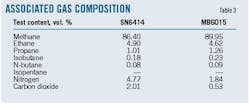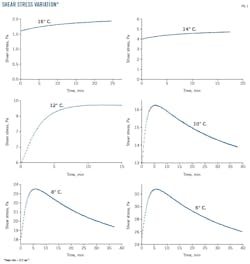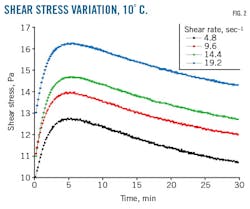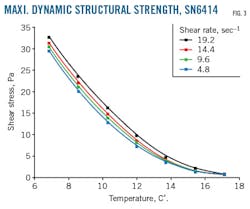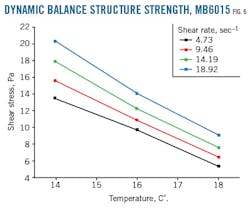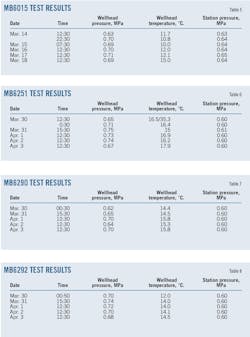Xiaoqin Xiong
China University of Petroleum
Karamay, China
Li Han
Genying Gao
Chao Ding
China National Petroleum Corp.
Karamay, China
Dissolved natural gas can reduce a crude oil’s pour point and viscosity, improving its low-temperature mobility. Decreased viscosity can reduce friction loss of the collector pipeline, increase distribution radius, and reduce on site heating requirements. A lower pour point, meanwhile, can reduce transportation temperature, perhaps to the point where a non-heat transfer is possible. Transfer without applying heat would increase efficiency and reduce energy consumption.
The expanding size of oil and gas gathering systems is taxing design limits based on pour point and the viscosity of degassing crude. Ensuring safe transportation has required heating the wellhead, adding hot or active water, or insulating the pipe, among other possible solutions. High pour point also increases the amount of energy consumed by complex transportation systems.
This article conducts a preliminary exploration of low temperature transportation of crude oil dissolved with natural gas.
Materials, methods
Researchers gathered the oil-gas samples from two Karamay-field wells (SN6414 and MB6015), degassing the oil to obtain separate samples. The degassing oil’s pour point was tested in accordance with the relevant provisions of standard SY/T0541-94 “Oil Pour Point Determination.”
Column chromatography and acetone-benzene adsorption measured the basic composition of the degassed crude. The composition of associated gas was analyzed using a CP-3800 gas phase chromatograph, with relative molecular weight and relative density determined based on the basic composition of the associated gas.
Experimental results have demonstrated that the yield value near an oil’s pour point is 5-15 Pa.4 This article applied continuous shearing to determine the Karamay crude’s dynamic structural strength at different temperatures and equivalent shear rates. Results allowed deduction of a dynamic pour point for the actual conveying process; i.e. a safe transport temperature, of great significance for a long-distance pipeline.
Pipeline throughput of SN6414 oil was 5 tons/day at a density of 826 kg/cu m and a pipeline ID of 53 mm (Equations 1-3). Table 1 shows the velocity gradient of pipeline flow at different throughputs. Using the calculation results, the dynamic structural strength of the two crudes was measured with the RV20 rheometer. SN6414 test temperature was 4-18° C., MB6015 14-26° C.
Experimental steps comprised:
• Filling sample. Crude was put into the rheometer until filled.
• Heat treatment. The rheometer’s water bath temperature was set to 50° C. for 20 min to eliminate the sample’s thermal and shear history.
• Cool, shear. The sample was cooled at 0.5-1.0° C./min to the desired temperature at the same time the rheometer was set with equivalent shear rate under the field pipe flow.
• Constant temperature shear. At the measured temperature the shear rate was kept unchanged, the oil sample cut, and the dynamic structural strength of live crude oil measured over time.
Experimental results, analysis
Table 2 shows the oil samples’ physical properties. The water content is very low, allowing its effect on the rheology of live crude oil to be ignored.
Crude oil with 2.5% wax content is called low-waxy crude, crude with wax content of 2.5-10% is called waxy crude, and crude with wax content greater than 10% is called high-waxy crude. SN6414 crude oil is waxy. MB6015 crude oil is high-waxy.
Table 3 shows that the main components of associated gas are methane, and small amounts of ethane, propane,
nitrogen, and carbon dioxide.
At the same shear rate the oil’s dynamic structural strength increased with decreasing temperature, and at different temperatures the change rule of its dynamic structure strength varied with time.
Under the constant shear rate of 19.2 sec-1 within the scope of 12-16° C., the shear stress of SN6414 sample increased with shear time as growth gradually leveled off. At 6-10° C. the waxy crude oil presented as thixotropic fluid, shear stress started near its maximum and gradually decreased over time (Fig. 1).
At the same temperature, crude’s dynamic structure strength increased with increasing shear rate. Fig. 2 shows SN6414’s shear stress under different shear rates at 10° C.
At different temperatures and shear rates, the maximum dynamic strength of crude oil also differs. At a given shear rate, maximum dynamic structural strength increased rapidly with decreasing temperature (Figs. 3-4).
At low temperatures crude takes on thixotropic characteristics, shear stress gradually decreasing with shear time, but also gradually reaching a balanced value; the dynamic balance structure strength at measurement condition (Figs. 5-6). Figs. 5-6 show that at the same shear rate, dynamic balance structure strength increases with decreasing temperature. At the same temperature, dynamic balance structure strength increases with increasing shear rate.
At a certain temperature, the dynamic structural strength of the crude oil was 5-15 Pa less than the equivalent shear rate. This temperature is the lowest transportation temperature. According to test results, SN6414’s minimum safe transportation temperature = 8° C., 6° C. lower than its static pour point. The minimum safe transportation temperature of MB6015 = 16° C., 8° C. lower than its static pour point.
Field test
Regular evaluation of thermal resistance values in the well area yielded ground temperatures of the operating pipeline (Table 4).
MB6015, MB6251, MB6290, and MB6292 wells served as field test sites. Wellhead pressure of the four ranged from 0.60-0.75 MPa with heating. Tables 5-8 show field test results for each well.
• MB6015. Wellhead oil pipe diameter = 25.6 in., length = 100 m, oil production = 15.9 t/d (water content 1%) with 220 normal cu m/t natural gas, and a static pour point of 24° C. The wellhead was heated to 34.5° C. before the experiment.
• MB6251. Wellhead oil pipe diameter = 25.6 in., length = 300 m, oil production = 11.3 t/d (water content 5.3%) with 125 normal cu m/t natural gas, and a static pour point of 24° C. The wellhead was heated to 35.3° C. before the experiment.
• MB6290. Wellhead oil pipe diameter = 25.6 in., length = 400 m, oil production = 10.1 t/d (water content 1.7%) with 153 normal cu m/t natural gas, and a static pour point of 24° C. The wellhead was heated to 35° C. before the experiment.
• MB6292. Wellhead oil pipe diameter = 25.6 in., length = 210 m, oil production = 14 t/d (water content 2.8%) with 202 normal cu m/t natural gas, and a static pour point of 24° C. The wellhead was heated to 34.8° C. before the experiment.
Field test results show that wellhead back pressure of the high pour point crude oil dissolved with gas, and without heating during transportation, rose less than 0.1 MPa, indicating that the pipeline was not frozen by blocking and that the non-heating transportation of high pour point crude oil with gas is feasible.
The authors
Xiaoqin Xiong ([email protected]) is an associate professor of China University of Petroleum at Karamay. She has also served as a deputy director of Engineering Technology Research Institute of Xinjiang Oilfield Co. She holds MS (2007) degrees in oil and gas storage and transportation from Southwest Petroleum University.
Li Han ([email protected]) is a senior engineer of China National Petroleum Corp. (CNPC)and the vice president of Engineering Technology Research Institute of Xinjiang Oilfield Co. He holds MS (2001) degrees in petroleum and natural gas engineering from Southwest Petroleum Institute.
Genying Gao ([email protected]) is an engineer of CNPC and the director of ground engineering at the Engineering Technology Research Institute of Xinjiang Oilfield Co. He holds BS (2007) degrees in thermal and power engineering from China University of Petroleum.
Chao Ding ([email protected]) is a senior engineer of CNPC and director of steam assisted gravity drainage (SAGD) at Xinjiang Oilfield Co. He holds BS (2005) degrees in petroleum and natural gas engineering from Southwest Petroleum Institute.




